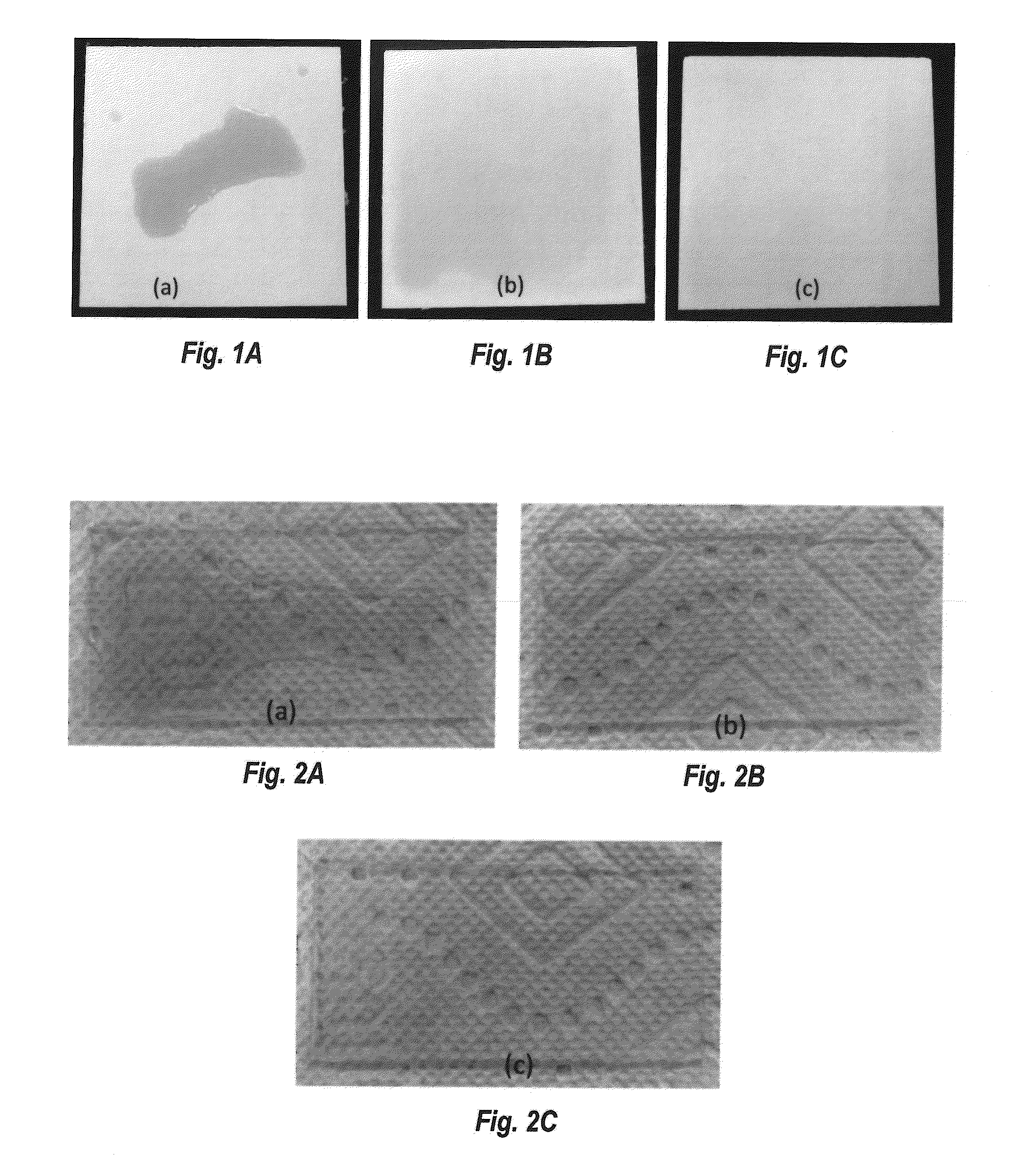Hypohalite compositions comprising a diallyl dimethyl ammonium chloride polymer
a technology of ammonium chloride and composition, which is applied in the direction of detergent composition, organic non-surface active detergent composition, soap detergent with other compounding agents, etc., can solve the problems of often less effective or ineffective brighteners of fabri
- Summary
- Abstract
- Description
- Claims
- Application Information
AI Technical Summary
Benefits of technology
Problems solved by technology
Method used
Image
Examples
example 1
Compositions of Sodium Hypochlorite Solutions Containing Poly(DiallylDimethyl Ammonium Chloride) (DADMAC)
[0062]The aqueous compositions described in the present application can be prepared by mixing the ingredients together. An example composition is shown in Table 1. No particular order of mixing is required, although the caustic is typically added last in order to adjust pH to a final range of 11.6-12.2. A typical preparation is described as follows for a hypochlorite solution containing 50 mM of poly(DADMAC) (concentration based on moles of one charged monomeric unit). To a beaker containing 83.55 grams of water was added 191.7 grams of 12.9% sodium hypochlorite solution. 24.14 grams of 10% poly(DADMAC) was added to this solution while stirring. Sodium hydroxide (50%) was added until the pH of the solution reached a target of 11.6-12.2. Water was added to balance.
[0063]
TABLE 1Example composition of the bleach product with varying poly(DADMAC) concentrations:PolySodiumPoly(DAD-(DA...
example 2
Stability of Sodium Hypochlorite Compositions Containing Poly(DADMAC)
[0065]
TABLE 3Hypochlorite degradation profiles of formulations with poly(DADMAC) after prolonged storage at 49° C.Concen-tration ofpoly(DAD-MAC)% Hypochlorite Remaining(mM)0 days4 days6 days10 days12 days14 days 0100%93.63%91.79%81.00%81.74%75.74% 5100%91.42%90.81%81.62%80.27%75.37%10100%90.69%89.46%82.11%80.39%75.98%20100%91.91%89.46%83.09%81.62%75.00%
[0066]As shown in Table 3, the hypochlorite degradation in formulations containing poly(DADMAC) is similar to the formulation without the polymer at elevated temperature, showing that the stability of hypochlorite is not appreciably affected by the presence of poly(DADMAC) at these levels.
example 3
Whiteness Enhancement of Laundered Fabrics—Fading of Fabrics with Sunlight and Weatherometer Photographs Depicting the Need for Brightening with Bleach
[0067]Testing was conducted to assess the whitening performance of product when used in a laundry wash experiment. Each set of tests were performed with Tide® detergent with Acti-Lift and traditional deep-fill top loader washing machines using the industry standard test method ASTM D4265. This testing measured the ability of each product to enhance whitening. Unbrightened cotton fabric and a cotton terry cloth fabric (Testfabrics, Inc.) were tested for brightener deposition. A set number of replicates were washed according to specifications and conditions recommended in the ASTM D 4265 method.
[0068]Whiteness was measured with a Konica Minolta CM-3600A spectrophotometer and delta W was calculated using the CIE 2000 color difference formula. The data was analyzed to determine the statistical difference between of each of the respective ...
PUM
| Property | Measurement | Unit |
|---|---|---|
| time | aaaaa | aaaaa |
| viscosities | aaaaa | aaaaa |
| viscosities | aaaaa | aaaaa |
Abstract
Description
Claims
Application Information
 Login to View More
Login to View More - R&D
- Intellectual Property
- Life Sciences
- Materials
- Tech Scout
- Unparalleled Data Quality
- Higher Quality Content
- 60% Fewer Hallucinations
Browse by: Latest US Patents, China's latest patents, Technical Efficacy Thesaurus, Application Domain, Technology Topic, Popular Technical Reports.
© 2025 PatSnap. All rights reserved.Legal|Privacy policy|Modern Slavery Act Transparency Statement|Sitemap|About US| Contact US: help@patsnap.com

